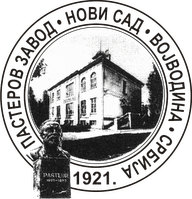
The Virus
Classification
Rabies virus belongs to the order Mononegavirales, viruses with a nonsegmented, negative-stranded RNA genome. Within this group, viruses with a distinct “bullet” shape are classified in the Rhabdoviridae family, which includes at least three genera of animal viruses, Lyssavirus, Ephemerovirus, and Vesiculovirus. The genus Lyssavirus includes rabies virus, Lagos bat, Mokola virus, Duvenhage virus, European bat virus 1 & 2 and a newly discovered Australian bat virus.
Structure
Rhabdoviruses are approximately 100-300 nm long and 75 nm wide. The rabies genome encodes five proteins: nucleoprotein (N), phosphoprotein (P), matrix protein (M), glycoprotein (G) and polymerase (L). All rhabdoviruses are having two major structural components: a helical ribonucleoprotein core (RNP) and a surrounding envelope. In the RNP, the genome RNA is tightly encased by the nucleoprotein. Two other viral proteins, the phospoprotein and the large protein (or polymerase) are associated with the RNP. The glycoprotein forms approximately 400 trimeric spikes that are tightly arranged on the surface of the virus. The M protein is associated both with the envelope and the RNP and may be the central protein of rhabdovirus assembly. Rabies virions are bullet-shaped with 10-nm spike-like glycoprotein peplomers covering the surface. Rabies has a genome of RNA. The rabies genome contains 5 genes that encode 5 proteins designated as N, P, M, G, and L. The arrangement of these proteins and the RNA genome determine the structure of the rabies virus. The rabies virus genome is single-stranded, antisense, nonsegmented, RNA of approximately 12 kb. There is a leader (LDR) of 50 nucleotides, followed by N, P, M, G, and L genes.
Replication
The fusion of the rabies virus envelope to the host cell membrane (adsorption) initiates the infection process. The interaction of the G protein and specific cell surface receptors may be involved. After adsorption, the virus penetrates the host cell and enters the cytoplasm by pinocytosis. The virions aggregate in the large endosomes (cytoplasmic vesicles). The viral membranes fuse to the endosomal membranes, causing the release of viral RNP into the cytoplasm. Since lyssaviruses have a linear single-stranded, negative-stranded ribonucleic cid (RNA) genome the complementary “positive” strand of RNA must be transcribed before virus replication. A viral polymerasease transcribes the negative strand of RNA into leader RNA and five capped and polyadenylated mRNAs, which are translated into proteins. Translation, which involves the synthesis of the N, P, M, G and L proteins, occurs on free ribosomes in the cytoplasm. Within the central nervous system (CNS), there is preferential viral budding from plasma membranes. Conversely, virus in the salivary glands buds primarily from the cell membrane into the acinar lumen. Specific viral budding into the saliva coupled with virus-induced behavioral changes, maximizes the chance of viral perpetuation through the directed bite and infection of a new host.
Immunity after vaccination
The history of active immunization by vaccine began 115 years ago with Louis Pasteur, who sought a post exposure vaccination against rabies in man. Pasteur protected a 9-year old boy after a rabid dog bite, using dried neural cord as a vaccine. Since Pasteur, vaccination schemes have been based on a continuous vaccine stimulus given for many days and/or multiple injections on the first day. The firs generation type of vaccine (nerve tissue culture) fails to fulfill the present standards of an efficient and safe immunoprophylaxis due to its low protective efficiency, high rate of neurocomplications and death rate. Current immunoprophylaxis is based on inactivated cell culture vaccine. Early, high, and long-lasting antibody induction became the criterion of a successful vaccination regimen.
Development of WHO approved BHK -21 (baby hamster kidney) cell culture vaccine request investigation immune response and its protective effects in man. Pasteur Institute in Novi Sad was beginning vaccination of human volunteers with this vaccine and our first results are very good.

